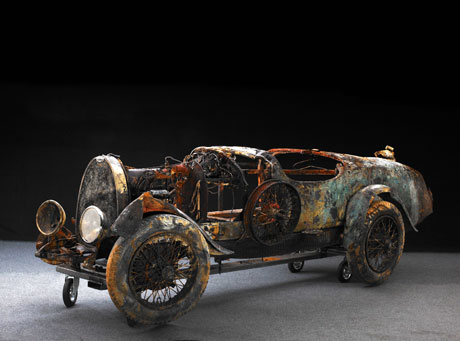SCM Analysis
Detailing
| Vehicle: | 1925 Bugatti Brescia Type 22 |
| Number Produced: | 2,000 approx. |
| Original List Price: | $1,607 (23,500FF) in 1925 |
| Tune Up Cost: | n/a |
| Distributor Caps: | n/a (magnetos) |
| Chassis Number Location: | Right front engine bearer |
| Engine Number Location: | Top of cam cover |
| Website: | http://www.bugatti.co.uk |
| Investment Grade: | A |
This car sold for $364,700, including buyer’s premium, at Bonhams’s Automobiles d’Exception Auction at Rétromobile in Paris, France, on January 23, 2010.
Rarely does a paradigm-changing event occur in the automobile world. Yet as I will explain below, the sale of this artifact represents such a moment. Sports Car Market readers who read the catalog entry before the sale no doubt marveled at the $100k-$125k estimate for what is arguably a marine archaeology find.
That the hulk should then make over $350,000 on the day is simply breathtaking. That price is, after all, the value of a decently running collector-grade Brescia Bugatti. Furthermore, the result could only have been achieved with at least two bidders; and, as it turns out, both bidders are connoisseurs with worldwide recognition.
When two great and experienced collectors struggle this fiercely, I don’t see the sale as aberrant. Something is going on here. Let’s look beyond a facile explanation involving “two nutters with battling checkbooks.”
First instance of a post-modernist sensibility
The subject lot represents the first instance of a buyer acting with a post-modernist sensibility that deconstructs the automobile as a rare archeological artifact. As many surmised before the sale, this automobile would go not to an “experiential” or use-oriented buyer with a desire to restore and drive, but rather to a “contemplative” buyer who would want the object “as is,” freshly raised from the depths of Lake Maggiore and looking like an artifact from a Spanish treasure galleon found by the National Geographic Society.
Unless our subject car was literally to be given away, no restoration scenario imaginable could make any sense. Even if not to be restored, there is still another cost factor that may yet play a part: conservation.
While fortunately submerged in fresh, rather than salt, water for 70 years, I can’t help thinking that this car will require the same hugely expensive museum conservation regimen demanded by other recovered submerged relics, wherein technicians in white lab coats, latex gloves, and magnifying spectacles must meticulously inject the exhibit with hypodermic syringes of acrylic consolidant to prevent it from crumbling to dust.
Therefore, only a museum, the archetypal “contemplative buyer,” could possibly want this car as-is. Not surprisingly, after spirited bidding, the car was acquired by a developing museum in the L.A. area devoted to a fabulous collection of French coachbuilt cars.
Here’s the main point: This car was bought, not as another impeccable object for the museum, but as an archeological relic. In fact, its identity, beyond that of being a relatively elitist French automobile from the 1920s and ’30s, had precious little relevance to the auction price. That is why, as an archeological object, its realized value exceeded the value of an intact, running Brescia Bugatti.
I see an emerging “reversion to the real”
Second, the zeitgeist played its part here. A decayed industrial relic of past glory resonates in these turbulent times. Thus, I see emerging a “reversion to the real”-a reaction to the artificially enhanced, primped, detailed, and hence epistemologically confusing collector car of accepted practice.
With this purchase, the buyer/curator wanted to show an irreproachably real object, an object connected to a distant past, hoary with age and decay. To that end, this artifact is a kind of memento mori for the collectible automobile from an age of excess.
From the standpoint of the museum and its exhibits, I would suggest that this lot was bought to contrast with the rest of the collection in the most poignant and striking way possible. It stands as an eloquent reminder of the fate that awaits almost all examples of the automobile-the single most important technological object of the 20th century-absent the intercession of connoisseurs, collectors, and museums.
There is little doubt that the Brescia will make a startling impact on the museum’s visitors. They will spend substantially more time contemplating this object, and will engage with it more than any other single automobile in the collection. This relic assumes a degree of historic gravitas, relevance, and yes, romance that makes a “silicone-enhanced and airbrushed” Best-in-Show winner at Pebble Beach historically weightless.
So, is it a good financial move to make an artificial reef out of our collector cars with the intent of dredging them up and selling them as priceless relics decades in the future? Probably not. Yet manifestly the romantic mystique of newly discovered treasure played an important factor in this transaction. Could our subject resell in five years for a similar price? I would say not.
Shattering the long-standing valuation paradigm of automobiles as having to be “usable history,” this car has achieved apotheosis by becoming an archeological artifact from the modern industrial age. Consequently, it commanded a price typical of an archeological rarity. As a financial transaction: very well sold. As a cultural artifact: brilliantly bought.
